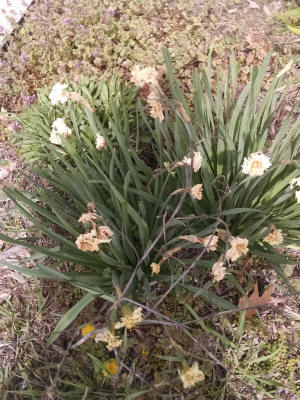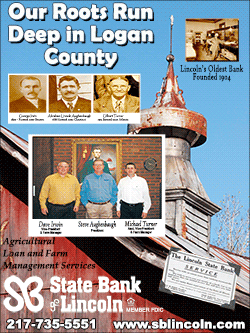|
 Of course we can expect some fruit reduction in cases where
severe frost or freezing catch trees in the tender bloom and
early fruit set stages. Book figures are about a 10% reduction
in apples at full bloom with a temperature of 28 degrees.
Peaches and apricots in early fruit set at similar temperatures
will see about a 25% fruit reduction. An additional decrease in
temperature to about 26 degrees magnifies the losses. Of course
this isn’t always bad. Many have been complaining the past
couple of years about too much fruit and broken branches. Of course we can expect some fruit reduction in cases where
severe frost or freezing catch trees in the tender bloom and
early fruit set stages. Book figures are about a 10% reduction
in apples at full bloom with a temperature of 28 degrees.
Peaches and apricots in early fruit set at similar temperatures
will see about a 25% fruit reduction. An additional decrease in
temperature to about 26 degrees magnifies the losses. Of course
this isn’t always bad. Many have been complaining the past
couple of years about too much fruit and broken branches.
Of bigger concern is rhubarb. A hard freeze can actually damage
leaf cells enough to release a toxin back into the leaf stalks.
The leaves are always toxic on rhubarb, and if damaged enough to
wilt or have black or brown along the edges, the toxin is almost
certainly released. The solution is rather simple, at least this
early in the game. Pull the stalks with the damaged leaves, and
you get to start over with the regrowth. It may happen again as
the plants have more growth, but at least now we are early
enough we don’t feel quite so bad about starting at ground level
again.

For those who got some potatoes out, if foliage is damaged
enough to wilt, it is probably best to cut tops back to ground
level and allow regrowth. Rotting back into the tubers causes
more problems later on.
Freeze Damage on Landscape Perennials

“Wait and see” is the best advice concerning perennials
subjected to the freezing temperatures of the last week.
Temperatures below 25 degrees are generally regarded as harmful
to budding and blooming plants. Temperatures of about 18 degrees
are more damaging. We were right in the 25 degree range
overnight.

Exposed flowers such as daffodils and tulips definitely took a
hit. The blooms exposed froze, and stems and flower buds froze.
What’s the outlook for the plants? Existing foliage, and new
growth, should provide plenty of foliage for the bulbs to store
energy to go through the winter. The bulbs are well protected
below the soil, and there should be no damage to bulbs planted
at the proper depth. Also, remember many of our perennials are
sheltered by the house or other structures, so damage may not
even be noticeable.
Trees and shrubs recommended for our hardiness zone should fare
well. They’ve been through this before, and probably will again.
Plants normally planted in more southern zones may suffer more
significant damage, while those normally planted further north
should suffer less. A lot of the damage is dependent on the
actual stage of development.
[to top of second column] |

Many of our flowering trees and shrubs that show early
blooms, such as dogwoods, Bradford pear, and redbuds, will lose
most if not all blooms. Even early trees will show significant
damage to the exposed fruit and leaf tissue and buds. Maple
trees in particular often show some frost cracks, and these will
be most significant on smaller diameter trees. Frost cracks are
long, vertical cracks in the main trunks of the trees. They heal
easily, and don’t cause long-term damage to trees. They are very
visible, and cause concern when they are discovered. The damage
is similar to a jug of water freezing. The trunk is full of sap,
and the freeze causes the sap to expand. This causes the large
crack. We probably did not have sustained freezing temperatures
for a long enough period to affect large diameter trees.
There will be some very tough looking foliage on some trees with
many black or brown tips or margins, similar to anthracnose
damage, as small leaves are forming on some trees. Later trees,
such as oaks, will show little or no effects due to the delayed
swelling of the buds.
Some plants are marginally hardy in our area. They will probably
show some dieback or death. Boxwoods traditionally are severely
affected by cold snaps at abnormal times. But once again, wait
and see. Abnormal pruning patterns may also cause more severe
injury.

In summary, healthy perennials will probably look somewhat rough
this year. There will probably be more damage to flower and
fruit buds than to leaf buds, but leaves may be misshapen or
have dead portions. If leaves were severely affected, a new set
of leaf buds will come out later. Of course this will take some
stored energy from the trees storage. The best thing we can do
is the simplest. Water when it is dry, and make sure to
fertilize at the right time. The blanket recommendation is to
use a “lawn rate” over everything. This would be 10 pounds of
10-10-10, or eight pounds of 12-12-12 or 13-13-13 per 1000
square feet. It is best to fertilize everything about the first
week of May. Wait and see. That’s the best advice for now.
[By JOHN FULTON, COUNTY EXTENSION
DIRECTOR SERVING LOGAN, MENARD, AND SANGAMON COUNTIES]
 |